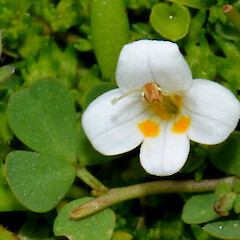Euphrasia repens
Synonyms
Euphrasia umbellata Petrie
Family
Orobanchaceae
Flora category
Vascular – Native
Endemic taxon
Yes
Endemic genus
No
Endemic family
No
Structural class
Herbs - Dicotyledons other than Composites
NVS code
The National Vegetation Survey (NVS) Databank is a physical archive and electronic databank containing records of over 94,000 vegetation survey plots - including data from over 19,000 permanent plots. NVS maintains a standard set of species code abbreviations that correspond to standard scientific plant names from the Ngä Tipu o Aotearoa - New Zealand Plants database.
EUPREP
Current conservation status
The conservation status of all known New Zealand vascular plant taxa at the rank of species and below were reassessed in 2017 using the New Zealand Threat Classification System (NZTCS) – more information about this can be found on the NZTCS website. This report includes a statistical summary and brief notes on changes since 2012 and replaces all previous NZTCS lists for vascular plants.
Please note, threat classifications are often suggested by authors when publications fall between NZTCS assessment periods – an interim threat classification status has not been assessed by the NZTCS panel.
- Conservation status of New Zealand indigenous vascular plants, 2017 . 2018. Peter J. de Lange, Jeremy R. Rolfe, John W. Barkla, Shannel P. Courtney, Paul D. Champion, Leon R. Perrie, Sarah M. Beadel, Kerry A. Ford, Ilse Breitwieser, Ines Schönberger, Rowan Hindmarsh-Walls, Peter B. Heenan and Kate Ladley. Department of Conservation. Source: NZTCS and licensed by DOC for reuse under the Creative Commons Attribution 4.0 International licence.
2017 | At Risk – Declining | Qualifiers: DP, RR, Sp
Previous conservation statuses
2012 | At Risk – Naturally Uncommon | Qualifiers: DP, Sp
2009 | At Risk – Naturally Uncommon
2004 | Range Restricted
Distribution
Endemic. South Island and Stewart Island/Rakiura: Coastal Fiordland to Toetoes Bay; coastal and sand pans of Stewart Island/Rakiura.
Habitat
Sandy, shingly and boggy places on coasts of Foveaux Strait and adjacent islets.
Wetland plant indicator status rating
Information derived from the revised national wetland plant list prepared to assist councils in delineating and monitoring wetlands (Clarkson et al., 2021 Manaaki Whenua – Landcare Research Contract Report LC3975 for Hawke’s Bay Regional Council). The national plant list categorises plants by the extent to which they are found in wetlands and not ‘drylands’. The indicator status ratings are OBL (obligate wetland), FACW (facultative wetland), FAC (facultative), FACU (facultative upland), and UPL (obligate upland). If you have suggestions for the Wetland Indicator Status Rating, please contact: [Enable JavaScript to view protected content]
OBL: Obligate Wetland
Almost always is a hydrophyte, rarely in uplands (non-wetlands).
Detailed description
Slender succulent annual herb usually forming matted patches. Stems much and often ± umbellately branched, branches creeping and rooting at nodes or ascending, usually flattened with membranous wings, glabrous or with sparse flattened jointed hairs. Leaves sessile and subsheathing at base, 2.5–4–(6) × 1–3 mm, oblong- to ovate-cuneate, upper ⅕-⅓ digitately divided into 3–5–(7) subacute to acute linear segments 0.5–2 mm long, middle segment usually greater than lateral segments, membranous when dry, glabrous or sparsely white-hairy, rarely with 1–2 setae at tips of segments. Flowers usually borne singly, subsessile or on pedicels up to 10 mm long. Calyx 3–4–(5) mm long, divided approximately ½ way; lobes lanceolate-triangular, acute, glabrous or occasionally setose at tips. Corolla white, (6)–10–13 mm long; tube slender, up to 9 mm long, much longer than calyx; lobes of lower lip up to 2 mm wide, entire. Anthers yellow to golden brown, glabrous or with a few marginal hairs, awns small, almost equal. Capsule shorter than calyx, densely setose at apex; seeds 2 per locule, 1.1–1.4 mm long, narrowly elliptic.
Similar taxa
Morphologically similar to Euphrasia dyeri, from which it differs by being a plant of coastal sands, usually creeping and rooting, often forming tight mats; leaves 2.5–4–(6) × 1–3 mm, divided not greater than ⅓ way, segments sub-acute to acute, middle segment usually wider than lateral.
Flowering
January–March.
Flower colours
White
Fruiting
February–April.
Life cycle
Seeds is dispersed by wind and possibly water and ballistic projection (Thorsen et al., 2009).
Etymology
euphrasia: Eye-medicine
repens: From Latin repere meaning to creep, means creeping
TAXONOMIC NOTES
In Allan (1961), Petrie distinguished his E. umbellata from E. repens by its larger size, more erect and not rooting habit, and larger, more divided leaves. Though the type specimens and other collections from the Oreti mouth are luxuriant and ascending as he described, they bear occasional roots at lower nodes, and the differences between these and dense mats of small-leaved rooting branches from Bluff and Fortrose seem wholly ascribable to habitat. Cheeseman (1925) treated the two species separately but remarked of E. umbellata: “I regard this as nothing more than a large state of E. repens”.
Attribution
Fact sheet prepared for NZPCN by M.D. Ward (3 November 2020) Description adapted from Allan (1961).
References and further reading
Allan HH. 1961. Flora of New Zealand, Volume I. Indigenous Tracheophyta: Psilopsida, Lycopsida, Filicopsida, Gymnospermae, Dicotyledones. Government Printer, Wellington, NZ. 1085 p.
Cheeseman TF. 1925. Manual of the New Zealand Flora. 2nd edition. Government Printer, Wellington, NZ. 163 p.
Thorsen MJ, Dickinson KJM, Seddon PJ. 2009. Seed dispersal systems in the New Zealand flora. Perspectives in Plant Ecology, Evolution and Systematics 11: 285–309.
Webb CJ, Simpson MJA. 2001. Seeds of New Zealand Gymnosperms and Dicotyledons. Manuka Press, Christchurch. 428 p.
Wilson HD. 1982. Field Guide: Stewart Island plants. Field Guide Publications, Christchurch, NZ. 528 p.
NZPCN Fact Sheet citation
Please cite as: Ward, M.D. (Year at time of access): Euphrasia repens Fact Sheet (content continuously updated). New Zealand Plant Conservation Network. https://www.nzpcn.org.nz/flora/species/euphrasia-repens/ (Date website was queried)







